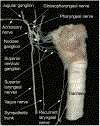Phenotypic distinctions between the nodose and jugular TRPV1-positive vagal sensory neurons in the cynomolgus monkey
- PMID: 30896676
- PMCID: PMC6481665
- DOI: 10.1097/WNR.0000000000001231
Phenotypic distinctions between the nodose and jugular TRPV1-positive vagal sensory neurons in the cynomolgus monkey
Abstract
Vagal capsaicin-sensitive afferent C-fibers play an important role in the maintenance of visceral homeostasis and contribute to symptoms in visceral diseases. Based on their developmental origin two functionally distinct types of vagal C-fibers are recognized: those with neurons in the vagal nodose ganglia (derived from epibranchial placodes) and in the vagal jugular ganglia (from neural crest). Studies in nonprimate species demonstrated that the vagal nodose and jugular C-fibers differ in activation profile, neurotrophic regulation, and expression of neurotransmitters. We hypothesized that the expression of selected markers related to key phenotypic properties of vagal C-fibers in the cynomolgus monkey is similar to that reported in nonprimate species. We performed single-cell RT-PCR on nodose and jugular putative C-fiber (TRPV1-positive) neurons isolated from the cynomolgus monkey. We found that the expression of purinergic P2X receptors that underlie selective responsiveness of nodose C-fiber terminals to ATP was conserved in that P2X2 and P2X3 subunits were expressed in nodose, but only P2X3 subunit was expressed in jugular TRPV1-positive neurons. Also conserved was the preferential expression of neurotrophic receptor TrkB in the nodose and preprotachykinin-A in the jugular TRPV1-positive neurons. Several key distinctions in gene expression between nodose and jugular TRPV1-positive (C-fiber) neurons that have been noted in mice, rats, and guinea pigs, are conserved in the cynomolgus monkey. Our results support the translatability of distinct vagal C-fiber phenotypes to primates.
Conflict of interest statement
Conflicts of Interest and Source of Funding
Conflict of interest: none declared.
Figures


Similar articles
-
P2X2 receptors differentiate placodal vs. neural crest C-fiber phenotypes innervating guinea pig lungs and esophagus.Am J Physiol Lung Cell Mol Physiol. 2008 Nov;295(5):L858-65. doi: 10.1152/ajplung.90360.2008. Epub 2008 Aug 8. Am J Physiol Lung Cell Mol Physiol. 2008. PMID: 18689601 Free PMC article.
-
TRPM8 function and expression in vagal sensory neurons and afferent nerves innervating guinea pig esophagus.Am J Physiol Gastrointest Liver Physiol. 2015 Mar 15;308(6):G489-96. doi: 10.1152/ajpgi.00336.2014. Epub 2015 Jan 15. Am J Physiol Gastrointest Liver Physiol. 2015. PMID: 25591866 Free PMC article.
-
Distinct Expression of Phenotypic Markers in Placodes- and Neural Crest-Derived Afferent Neurons Innervating the Rat Stomach.Dig Dis Sci. 2018 Feb;63(2):383-394. doi: 10.1007/s10620-017-4883-5. Epub 2017 Dec 23. Dig Dis Sci. 2018. PMID: 29275446
-
Sensory input to the central nervous system from the lungs and airways: A prominent role for purinergic signalling via P2X2/3 receptors.Auton Neurosci. 2015 Sep;191:39-47. doi: 10.1016/j.autneu.2015.04.006. Epub 2015 Apr 29. Auton Neurosci. 2015. PMID: 25953244 Review.
-
Interaction between TRPA1 and TRPV1: Synergy on pulmonary sensory nerves.Pulm Pharmacol Ther. 2015 Dec;35:87-93. doi: 10.1016/j.pupt.2015.08.003. Epub 2015 Aug 14. Pulm Pharmacol Ther. 2015. PMID: 26283426 Free PMC article. Review.
Cited by
-
Variability in P2X receptor composition in human taste nerves: implications for treatment of chronic cough.ERJ Open Res. 2023 Apr 11;9(2):00007-2023. doi: 10.1183/23120541.00007-2023. eCollection 2023 Mar. ERJ Open Res. 2023. PMID: 37057093 Free PMC article.
-
Molecular identity, anatomy, gene expression and function of neural crest vs. placode-derived nociceptors in the lower airways.Neurosci Lett. 2021 Jan 18;742:135505. doi: 10.1016/j.neulet.2020.135505. Epub 2020 Nov 13. Neurosci Lett. 2021. PMID: 33197519 Free PMC article. Review.
-
The translational revolution of itch.Neuron. 2022 Jul 20;110(14):2209-2214. doi: 10.1016/j.neuron.2022.03.031. Epub 2022 Apr 20. Neuron. 2022. PMID: 35447089 Free PMC article. Review.
-
Activation of a nerve injury transcriptional signature in airway-innervating sensory neurons after lipopolysaccharide-induced lung inflammation.Am J Physiol Lung Cell Mol Physiol. 2020 May 1;318(5):L953-L964. doi: 10.1152/ajplung.00403.2019. Epub 2020 Mar 11. Am J Physiol Lung Cell Mol Physiol. 2020. PMID: 32159971 Free PMC article.
-
Cardiac vagal afferent neurotransmission in health and disease: review and knowledge gaps.Front Neurosci. 2023 Jun 7;17:1192188. doi: 10.3389/fnins.2023.1192188. eCollection 2023. Front Neurosci. 2023. PMID: 37351426 Free PMC article. Review.
References
-
- Baker CV, Bronner-Fraser M. Vertebrate cranial placodes I. Embryonic induction. Dev Biol 2001; 232: 1–61. - PubMed
-
- Rhoton AL Jr., O’Leary JL, Ferguson JP. The trigeminal, facial, vagal, and glossopharyngeal nerves in the monkey. Afferent connections. Archives of neurology 1966; 14: 530–540. - PubMed
-
- Satoda T, Takahashi O, Uchida T, Mizuno N. An anterograde-retrograde labeling study of the carotid sinus nerve of the Japanese monkey (Macaca fuscata). Neuroscience research 1995; 22: 381–387. - PubMed
-
- Kummer W, Fischer A, Kurkowski R, Heym C. The sensory and sympathetic innervation of guinea-pig lung and trachea as studied by retrograde neuronal tracing and double-labelling immunohistochemistry. Neuroscience 1992; 49: 715–737. - PubMed
Publication types
MeSH terms
Substances
Grants and funding
LinkOut - more resources
Full Text Sources
Other Literature Sources

